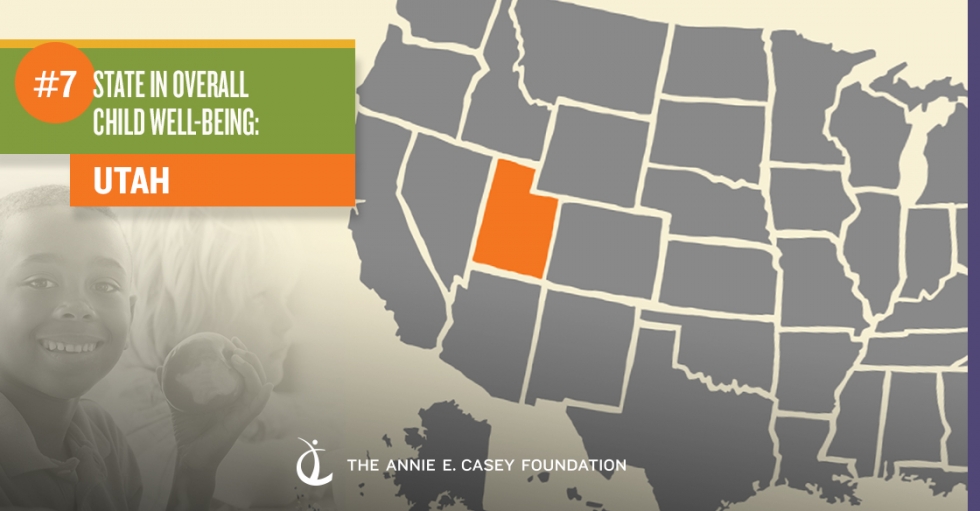Voices for Utah Children recently released our annual data book Measures of Child Well-Being in Utah along with the National Annie E. Casey Data Book. These annual publications provide citizens, advocates, community leaders and policymakers with the most timely and comprehensive data regarding the health and well-being of Utah's children. Combined, these publications provide a look at how Utah compares to the rest of the nation, as well as a more in-depth picture of child well-being at the county level. Used together, these data books are a reliable source for accurate information that can help shape priorities and policies to improve the well-being of Utah's children.
If we had a crystal ball that told us how our children would be doing two, five, or ten years down the road we could make thoughtful, calculated policy decisions. To make plans for an increasing number of children it is imperative that we have good data on how children have fared in the past and how that compares to today. That is one of the basic premises of the KIDS COUNT Project - provide accurate, accessible data to make sure the future that is “just around the corner” is a positive one for all of Utah’s children.
One of the things we know about children in Utah is that there will be more of them in the future. Population estimates from the U. S. Census Bureau indicate that the number of children in Utah in 2011 was 882,354. By 2015 that number had risen to 912,496. By 2050, the Utah Governor’s Office of Planning and Budget projects that Utah’s child population will be well over a million at 1,388,651. With an expanding child population, it is important to understand what the needs are today so we can plan for tomorrow. So how are the children doing?
According to the National Data book, improvements have been achieved across almost all key areas of well-being for children. The state is ranked seventh nationally in overall child well-being, landing in the top ten for both child economic well-being and family and community context. This data points to the fact that children in Utah are benefiting from state policies aimed at helping them succeed.
Boosted by the Children’s Health Insurance Program (CHIP), Medicaid and a push for outreach, Utah has dramatically increased access to health insurance for children: Between 2014 and 2015, 20,000 fewer children lacked coverage. This progress has helped Utah recover from a fall to 27th place in child health last year, and the state now ranks 19th nationally. However, at 7%, the percentage of children without insurance is still above the national average and more can be done to provide kids with the health and security proven to better position them for success later in life.
The annual KIDS COUNT Data Book uses 16 indicators to rank each state across four domains — health, education, economic well-being and family and community — that represent what children need most to thrive. Utah ranks:
- 5th in economic well-being. At 20 percent, Utah has one of the nation’s lowest percentages of children who have no parent with full-time, year-round employment. However, the percentage of children living in poverty remained unchanged at 13 percent between 2014 and 2015.
- 15th in education. The state saw decreases in the percentage of eighth graders scoring below proficient in math, fourth graders who were below proficient in reading, and in the number of 3- and 4-year-olds not attending school.
- 3rd in the family and community domain. Just 5 percent of children in Utah live in high-poverty areas, which is well below the national average of 14 percent. The teen birth rate has fallen to 18 births per 1,000 females.
- 19th in health. The percentage of teens abusing drugs and alcohol remained at 5 percent for the third consecutive year. The child and teen death rate also hovers at the national average of 25 deaths per 100,000 children.
Along with critical gains in health, the 2017 Data Book shows that investments in early childhood education are paying off. Utah exceeds the national average for its percentages of fourth graders meeting proficiency in reading, eight graders meeting proficiency in math and high schoolers graduating on time. Utah also saw a decrease in the percentage of children ages 3 and 4 who are not in school, a trend that is likely to continue as positive policies such as SB 101 — which makes it possible to offer scholarships for quality preschool to families living in intergenerational poverty — are implemented. Positive policies such as this will have profound impacts on children’s lives.
Supplementing the National Data Book is Measures of Child Well-Being in Utah, an annual publication from Voices for Utah Children that presents county-level data to local policymakers and planners. Measures of Child Well-Being in Utah also provides information at the state-level on racial and ethnic disparities and it highlights emerging trends. In Utah, child death rates, suicide rates, and chlamydia rates are all on the rise. While the percentage of uninsured kids has been improving, this indicator will be affected by future policy decisions around Medicaid and CHIP.
Measures show that the percent of kids in poverty in Utah has declined slightly but there are differences depending on where you live and if you are a child of color. Statewide, almost 13% of kids live in poverty, around 116,000 children. However, 25% of Latino/a children live below the poverty level and county poverty levels range from a low in Morgan of 5.3% and a high of 31.9% in San Juan County.
Education data in Measures indicates that, once again, more children are enrolled in our schools than the year before. From Fall of 2015 to Fall of 2016 enrollment increased by 11,680 students. And this yearly increase is a common occurrence.
The Utah KIDS COUNT Project is funded by the Annie E. Casey Foundation whose primary mission is to foster public policies, human-service reforms, and community supports that more effectively meet the needs of today’s vulnerable children and families. By providing policymakers and citizens with benchmarks of child well-being, KIDS COUNT seeks to enrich local, state, and national discussions of ways to secure better futures for all children. It is intended to gauge the seriousness of the problems facing children, and to guide the policy trends and goals on behalf of children. Using these two publications together, KIDS COUNT can measure child outcomes and contribute to public accountability for those outcomes.
For 30 years now, Voices for Utah Children has called on our state, federal and local leaders to put children’s needs first. But the work is not done. The children of 30 years ago now have children of their own. Too many of these children are growing up in poverty, without access to healthcare or quality educational opportunities.
How can you be involved?
Make a tax-deductible donation to Voices for Utah Children—or join our Network with a monthly donation of $20 or more. Network membership includes complimentary admission to Network events with food, socializing, and opportunity to meet child advocacy experts. And don't forget to join our listserv to stay informed!
We look forward to the future of Voices for Utah Children and we hope you will be a part of our next 30 years.
Special thanks to American Express, our "Making a Difference All Year Long" sponsor. 






